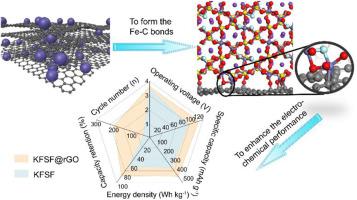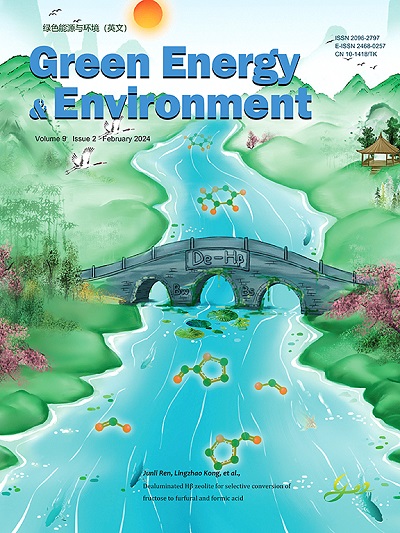Interface defect induced upgrade of K-storage properties in KFeSO4F cathode: from lowered Fe-3d orbital energy level to advanced potassium-ion batteries
IF 10.7
1区 工程技术
Q1 CHEMISTRY, PHYSICAL
引用次数: 0
Abstract
KFeSO4F (KFSF) is considered a potential cathode due to the large capacity and low cost. However, the inferior electronic conductivity leads to poor electrochemical performance. Defect engineering can facilitate the electron/ion transfer by tuning electronic structure, thus providing favorable electrochemical performance. Herein, through the regulation of surface defect engineering in reduced graphene oxide (rGO), the Fe-C bonds were formed between KFSF and rGO. The Fe-C bonds formed work in regulating the Fe-3d orbital as well as promoting the migration ability of K ions and increasing the electronic conductivity of KFSF. Thus, the KFSF@rGO delivers a high capacity of 119.6 mAh g-1. When matched with a graphite@pitch-derived S-doped carbon anode, the full cell delivers an energy density of 250.5 Wh kg-1 and a capacity retention of 81.5% after 400 cycles. This work offers a simple and valid method to develop high-performance cathodes by tuning defect sites.

界面缺陷诱导KFeSO4F阴极储钾性能的提升:从低Fe-3d轨道能级到高级钾离子电池
KFeSO4F (KFSF)因其容量大、成本低而被认为是极具潜力的阴极。但由于导电性能差,导致其电化学性能较差。缺陷工程可以通过调整电子结构来促进电子/离子的转移,从而提供良好的电化学性能。本文通过对还原氧化石墨烯(rGO)表面缺陷工程的调控,在KFSF和rGO之间形成了Fe-C键。形成的Fe-C键可以调节Fe-3d轨道,促进K离子的迁移能力,提高KFSF的电子导电性。因此,KFSF@rGO提供了119.6 mAh g-1的高容量。当与graphite@pitch-derived s掺杂碳阳极匹配时,经过400次循环后,整个电池的能量密度为250.5 Wh kg-1,容量保持率为81.5%。这项工作提供了一种简单而有效的方法,通过调整缺陷位置来开发高性能阴极。
本文章由计算机程序翻译,如有差异,请以英文原文为准。
求助全文
约1分钟内获得全文
求助全文
来源期刊

Green Energy & Environment
Energy-Renewable Energy, Sustainability and the Environment
CiteScore
16.80
自引率
3.80%
发文量
332
审稿时长
12 days
期刊介绍:
Green Energy & Environment (GEE) is an internationally recognized journal that undergoes a rigorous peer-review process. It focuses on interdisciplinary research related to green energy and the environment, covering a wide range of topics including biofuel and bioenergy, energy storage and networks, catalysis for sustainable processes, and materials for energy and the environment. GEE has a broad scope and encourages the submission of original and innovative research in both fundamental and engineering fields. Additionally, GEE serves as a platform for discussions, summaries, reviews, and previews of the impact of green energy on the eco-environment.
 求助内容:
求助内容: 应助结果提醒方式:
应助结果提醒方式:


